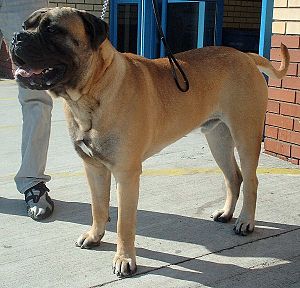Bullmastiff
| Bullmastiff | ||
|---|---|---|
|
|
||
| FCI Standard No. 157 | ||
|
||
| Patronage : | ||
| Withers height: |
Male: 64–69 cm. |
|
| Weight: |
Males 50–59 kg, |
|
| List of domestic dogs | ||
The Bullmastiff is a British dog breed recognized by the FCI ( No. 157, Gr. 2, Sec. 2.1 ) .
Origin and history
The Bullmastiff has been widespread in England since the 19th century and is therefore a comparatively young breed. It originated from a cross between Old English Mastiff and Old English Bulldog (not Olde English Bulldogge ) and was bred as a guard dog for game rangers. Due to the poor social conditions at the time, poachers reduced the game population in the landlords' property, which the gamekeepers tried to prevent. The imposition of the death penalty on poaching made the situation increasingly dangerous for the rangers, as a harassed poacher was considering the possibility of killing the ranger to avoid the death penalty in the face of a threatened arrest. The gamekeepers then used large breeds of hunting dogs (including Irish Wolfhounds ) to catch the poachers, who were often critically injured or even killed and torn up due to the pronounced hunting instinct of the dogs used and were therefore no longer available for a broad-based public execution. So you needed a big, strong dog that was quiet and fearless, but very controlled, to catch the poacher relatively unharmed.
The crossing of mastiff (approx. 60%) and English bulldog (approx. 40%) resulted in suitable dogs for this task; By later crossing the Bloodhound with his highly developed sense of smell , the trackability could be improved considerably. Through continuous selection during the dangerous nightly missions, an excellent guard dog was created, which was initially often referred to as "Gamekeeper's Nightdog".
On December 24, 1924, this new breed with the name "Bullmastiff" was recognized by the English Kennel Club as an independent dog breed. The breeder SE Moseley with his “Farcroft” kennel played a major role in spreading the breed beyond the borders of England. His parent male was called Farcroft Fidelity and was one of the most famous early Bullmastiffs.
Brief description
The Bullmastiff is a large dog with a height of up to 69 cm and a massive dog with a body weight of up to 60 kg. His hair is short and hard, lying smoothly, in every shade, from brindle, fawn or red, with a black mask. The ears are V-shaped, folded back, wide and high, set on level with the occiput; they give the skull a square appearance.
If its interest is aroused, the Bullmastiff has the peculiarity of wrinkling its forehead clearly - this silently indicates to its guide that something remarkable is happening.
use
In the 20th century , the Bullmastiff no longer had an essential role in combating poaching, but its abilities were discovered in other areas. His psychological effect on possible opponents, but also his detection dog skills qualify him as a very universally applicable service dog for various authorities (for example the British and American police) worldwide.
In addition, he has become a valued family dog, who reliably protects his "pack" against any threat and is good at handling children.
Essence
The breed standard describes the ideal type of Bullmastiff as powerful, persistent, active and reliable. In addition, the Bullmastiff is said to be very lively, vigilant, and loyal.
Racial Issues
The Bullmastiff is listed as a listed dog in some German federal states and in the Swiss cantons of Geneva and Ticino , although keeping it is prohibited in Geneva. In Austria , the Bullmastiff is on the breed list in two of the three list-leading federal states ( Vienna and Vorarlberg ). Depending on the federal state, a " dog handler license " (Vienna) or a special permit from the mayor (Vorarlberg) is required.
Diseases typical of the breed
The Calvarial-hyperostosis syndrome is a rare disease with painful swellings of the skull that occurs in young animals within the first year of life.
Individual evidence
- ↑ Breed standard No. 157 of the FCI: Bullmastiff (PDF)
- ↑ Information page of the Federal Chancellery of the Republic of Austria: keeping fighting dogs (accessed on October 28, 2015)
literature
- Ullrich Bossert, Jörg Ulrich: What a wonderful dog! Bullmastiffs in Germany. 4th edition. Verlag Ulmer Manuskripte, Blaubeuren / Ulm 2007, ISBN 978-3-934869-00-4 .

